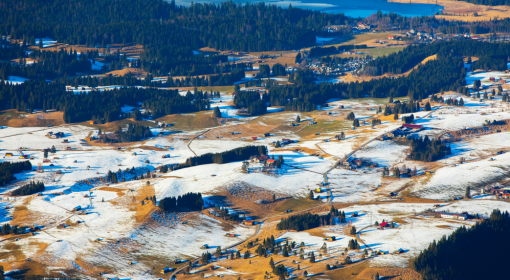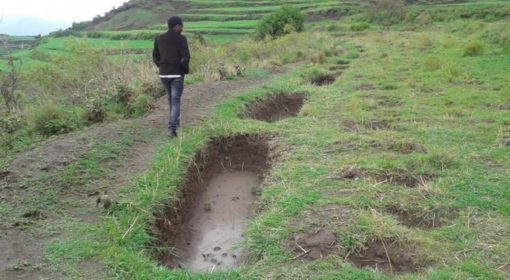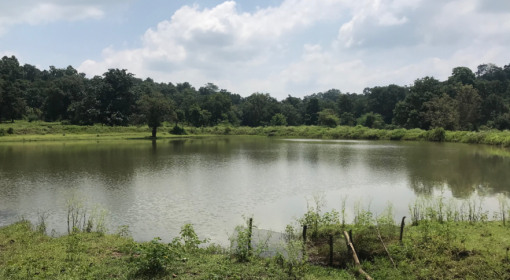By Femke van Woesik
June 21, 2021
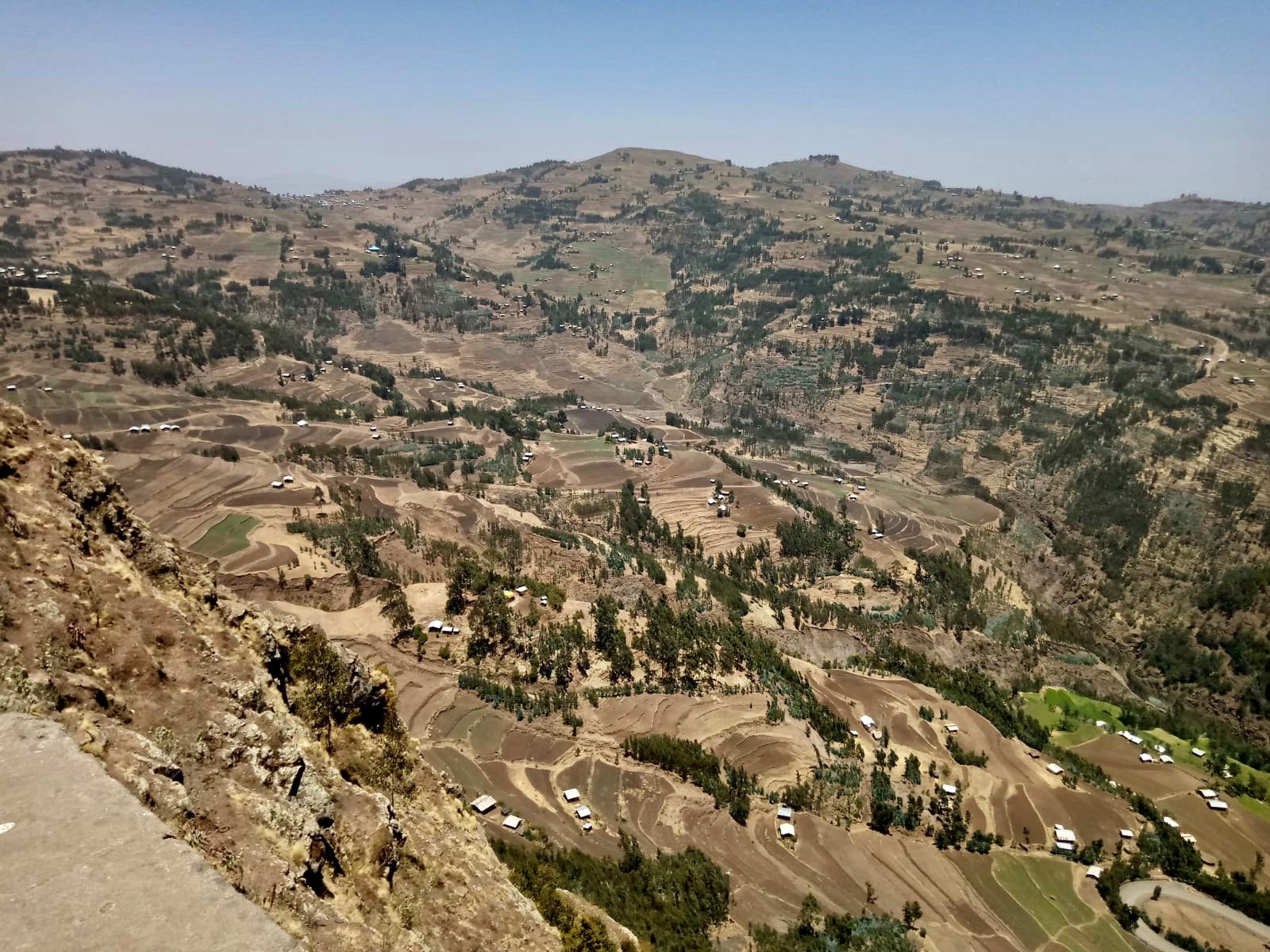
Climate change threats and fragile ecosystems are threatening agricultural production and resulting in lower agricultural capacity. This highlights the importance of building climate resilience and improving conditions for better agricultural yield. Increasing climate resilience at a farm level can be done by microclimate management. As was highlighted in an earlier piece, the management of microclimates is a powerful but not well understood frontier in smoothening out the impact of climate change and creating more resilient agricultural ecosystems. This blog will pick up the baton and explore how microclimate management can be made practical in the form of an assessment tool.
Microclimates are the local interplays between several factors: solar radiation, soil moisture, soil temperature, air temperature, air humidity, and wind direction and speed. These microclimatic interplays occur on a small scale with a horizontal range between centimetres and a hundred meters and a vertical range between centimetres and ten meters from the ground; or determined by the canopy boundary layer[1]. Microclimates are thus the conditions in which crops grow, making them an essential factor in agriculture. Due to the high local variability in different soil types, surface slope and orientation, and vegetation cover, this microclimatic scale is highly variable. This high variability differentiates the microclimate from the macroclimate just a few meters above, where atmospheric mixing processes are more active, leading to more moderate and stable conditions[2]. On this higher level, climatic conditions are more challenging to control, and there is only a slight chance for humans to modify this climate[3]. However, unlike this macroclimate, microclimates can be managed. Focusing on a microclimatic scale of a small plot or a single planting mound brings the climate back to more manageable levels. This can be done by making changes in a landscape. Certain land and water management interventions on a site affect the microclimate and, if done right, can improve it. As the microclimate is the scale on which plants grow, modifying the microclimate can improve the plant growth conditions[4]. Improving the microclimate on a farm level can increase crop production and land productivity by enhancing the agricultural ecosystem resilience.
Water conservation practices, such as trenches and ridge-furrow planting, are examples of interventions on a site that can improve the microclimate. By increasing the soil moisture, the evaporation from a site is enhanced. This enhanced evaporation means that more energy will be used in the latent heat fluxes and less in the sensible heat fluxes. Since the sensible heat fluxes contribute to the air temperature, less sensible heat flux will contribute to lower air temperatures[5]. The uptake of latent heat due to the available soil moisture provides an additional daytime cooling effect on a site[6].
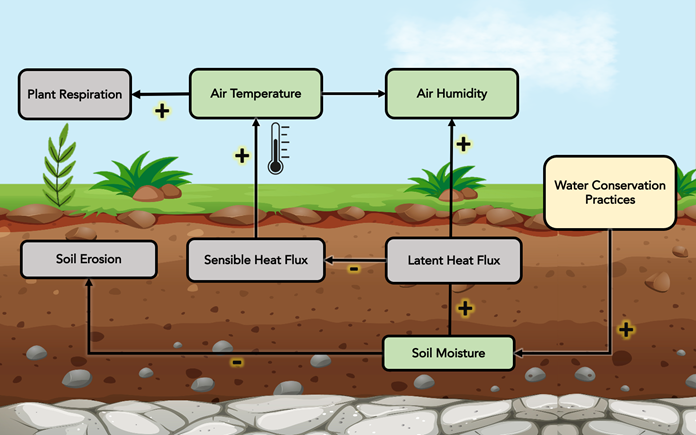
Increased soil moisture also balances the soil temperature extremes by increasing thermal conductivity, promoting heat diffusion in the soil. This lowers the extremes in both daytime heating and nocturnal cooling, protecting the crop root system against sharp and sudden soil temperature changes[7]. This moderation of soil and air temperatures extremes thus increase a farm’s resilience in the light of climate change. Ridges made on a field also impact the amount of solar radiation received by the surface since the site’s slope affects the absorbed radiation intensity. By manipulating the geometry of receiving surfaces, better use of available short-wave radiation can be accomplished[8]. Next, the furrows provide a radiative ‘trap’ for solar radiation and outgoing long-wave radiation. Finally, by enhancing surface water storage, trenches increase the number of water surfaces on a site[9]. Since water surfaces are poor reflectors, this serves as an effective sink for solar energy as well. Many water-filled trenches on a site thus absorb the solar energy during the day and radiate this back by night, buffering the air temperatures.[10] There are many land- and water management intervention options through which humans can modify the microclimate. Other examples are windbreaks, applying mulching material, altering row orientation and spacing, stone bunds, and vegetation regeneration.
Determining which intervention is best suitable for a farm depends on that particular site. This highlights the need for an assessment tool that reflects local nuances and provides guidance for each specific situation. Such a tool can be built by translating the workings of the microclimatic system into a set of questions and decisions that guides its user to the best suitable intervention to improve its specific microclimatic issues, such as too little soil moisture or too high air temperatures, on the site. This decision tree should be supplemented with landscape characteristics requirements to make the advice suitable for the particular site. Some interventions will not be possible on a farm with a very steep slope or without any access to stones, for example. Notably, a tool should be built upon both a scientific knowledge base and field-level expertise.
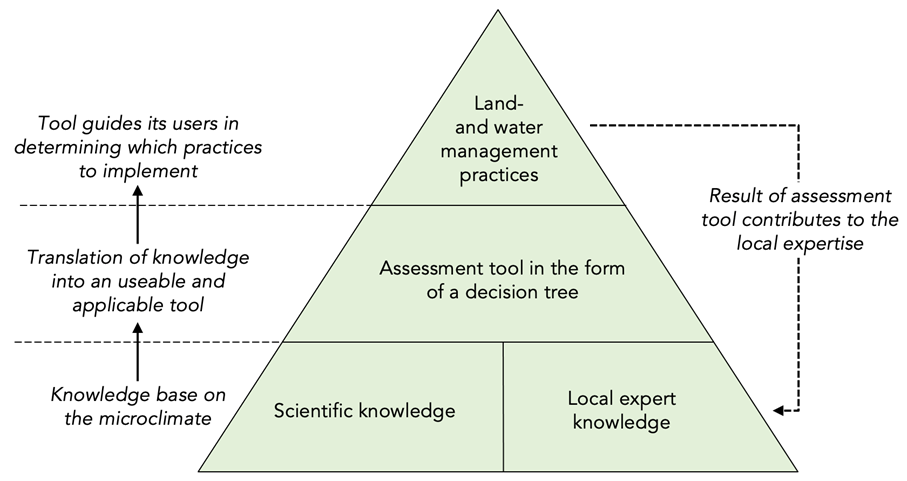
This way, local expertise is recognized, and local nuances are taken into account by tailoring microclimate management to the local context. Such a tool will also contain a learning feature by contributing the results back to the local experts. The more an assessment tool is tailored to a specific situation, the better its workings and the more likely it will be used by potential end-users[11]. This makes a microclimate management assessment tool an essential component in smoothing out the impacts of climate change, enhancing farm resilience, and stabilizing agricultural ecosystems. With more climate disruptions inherent and at the same time the urgency to increase farm production, there is an urgent need for further development of such tools.
Related Video: Managing Microclimates
References
[1] Yoshino, M. (1987). Local climatology. The Encyclopedia of climatology (Edited by JE Oliver and RW Fairbridge). New York, United States of America: Springer.
[2] Unwin, D. M., & Corbet, S. A. (1991). Insects, plants, and microclimate (Naturalists’ handbooks Series, Band 15). Oxford, United Kingdom: Richmond Publishing.
[3] Gliessman, S. R. (2015). Agroecology: The Ecology of Sustainable Food Systems (Third Edition). Oxford, United Kingdom: Taylor & Francis Group.
[4] Hadid, A., & Toknok, B. (2020). Vegetable and food crop production with microclimate modification. Journal of Physics: Conference Series (1434, No. 1, p. 012027). Bristol, United Kingdom, IOP Publishing.
[5] Gardner, C. M., Laryea, K. B., & Unger, P. W. (1999). Soil physical constraints to plant growth and crop production. Rome, Italy: Land and Water Development Division, Food and Agriculture Organization.
[6] Ismangil, D., D. Wiegant, Eyasu Hagos, F. van Steenbergen, M. Kool, F. Sambalino, G. Castelli & E. (2016). Managing the Microclimate. Flood-Based Livelihood Network – Practical Note 27. 10.13140/RG.2.2.15110.78409.
[7] Rosenberg, N. J., Blad, B. L., & Verma, S. B. (1983). Microclimate: the biological environment. New Jersey, United States of America: John Wiley & Sons.
[8] Gardner, C. M., Laryea, K. B., & Unger, P. W. (1999). Soil physical constraints to plant growth and crop production. Rome, Italy: Land and Water Development Division, Food and Agriculture Organization.
[9] Oke, T. R. (1995). Boundary layer climates (Second Edition). London, United Kingdom: Routledge.
[10] Stoutjesdijk, P., & Barkman, J. J., (1992). Microclimate, Vegetation and Fauna. Uppsala, Sweden: Opulus Press.
[11] Rose, D. C., Sutherland, W. J., Parker, C., Lobley, M., Winter, M., Morris, C., … & Dicks, L. V. (2016). Decision support tools for agriculture: Towards effective design and delivery. Agricultural systems, 149, 165-174.

